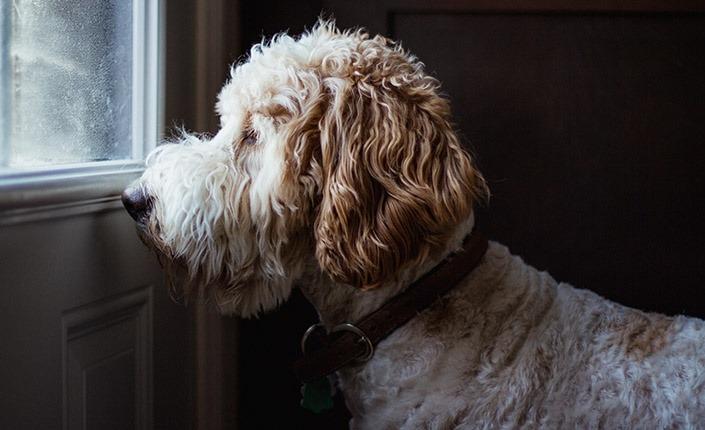Avoid Separation Anxiety in Your Dog

As COVID-19 physical distancing protocols ease up, many people can expect to return to their workplaces in the weeks ahead. While your cat may be grateful for the extra solitude, your dog may struggle with the sudden withdrawal of your 24/7 company. Separation anxiety can develop during lifestyle changes or transitions in a dog’s life. A new adoption, a move, the addition or loss of another pet, and changes in the owner’s routine can all make your pet insecure when you leave the house.
As we have all experienced this year, changes to our routine can be distressing and disorienting. For our dogs, separation anxiety is a condition, with varying degrees of severity, in which a dog exhibits distress and other behavioural issues when separated from their owner. It can be expressed through behaviour changes, disruptive barking, destructive behaviours like scratching or chewing, or even behaviours that can lead to injury. The wind-up to separation anxiety begins as the pet owner prepares to leave the house, and the most disruptive and destructive behaviour usually occurs in the first 20 minutes after owner departure. The key to avoiding separation anxiety lies in keeping your dog relaxed and happy during this window of time. Some careful planning will help make sure your work day means snooze-time and not stress-time for your dog.
Here are some tips to help your dog ease out of the work-from-home lifestyle and how to relieve separation anxiety in your dog:
- Start shifting your dog’s walk-times to the hours when you would normally be at home during a pre-COVID work week
- Limit walk duration and frequency to amounts that are reasonable and achievable for your away-from-home work schedule
- During the day, make sure your dog spends more time in the area normally designated for them when you’re away from home (such as a crate, the kitchen, or your bedroom)
- Leave your pet at home alone for short periods of time during the day. Lengthen that time with practice
- Offer your pet an appealing and time-consuming toy or treat when you leave. Stuffed Kong toys, treat balls, hide chews, and even kibble in an ice-cube tray work well
- Make your departure as uneventful as possible – skip any prolonged or dramatic goodbyes
- Be subtle and quiet about your departure routines – zipping coats, collecting bags, jingling keys
- Consider “faking” your departure routine several times in the weeks leading up to your eventual return to the office
- Leave some comforting noise on when you leave, such as quiet music or the TV
- Make your return home as uneventful and low-key as possible
- Consider using mild anxiety-reducing tools such as Adaptyl®, a ThunderShirt, or even calming supplements
If your dog experiences separation anxiety despite these measures, consult your family veterinarian for additional behaviour-modifying options and advice. Best of luck, to you and your pup, if you are returning to work!
The information provided and contained herein are the opinions of PTZ Insurance Services Ltd. which are based on external publication. The content is not intended to be a substitute for professional veterinary advice. PTZ Insurance Services Ltd. assumes no responsibility or liability for any loss, claims or damages arising out of the within content.